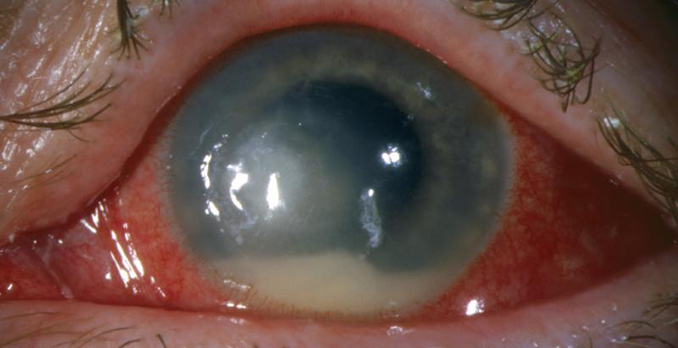
Differential Diagnoses
Bacterial keratitis
Acanthamoeba keratitis
Herpes simplex virus stromal keratitis
Corneal foreign body
Diagnosis
Fungal corneal ulcer
Learnings
A fungal corneal ulcer, or fungal keratitis, is an infection of the corneal stroma that can cause rapid vision loss and pain. Infectious corneal ulcers must be treated as soon as possible to preserve vision. If left untreated, a fungal infection can lead to perforation of the cornea, loss of vision, and even loss of the eye. Risk factors that can predispose to fungal keratitis include contact lens wear, eye trauma with vegetative matter, previous ocular surgery, topical steroid use, and immunosuppression. Patients with a fungal corneal ulcer will report eye pain, light sensitivity, eye redness, and possibly reduced vision. The rapidity of symptom onset and progression is typically slower than what is seen in bacterial keratitis. Fungal keratitis is much less common than bacterial keratitis, and the diagnosis is often made once traditional antibacterial medications fail to successfully treat an infection. Yeast-like fungal species, such as Candida, are more common in fungal keratitis in the northern United States, whereas filamentous organisms, such as Fusarium, are more common in the southern United States.
What to Look For
Examination of a patient with a fungal corneal ulcer will show injected conjunctiva, often with a more intense ring of injection at the limbus (ciliary flush). Examination of the cornea will commonly show a white infiltrate in the stroma. Fungal corneal infiltrates will often have satellite lesions and feathery borders and may be covered by intact epithelium. The corneal infiltrate may be <1 mm or may encompass the entire cornea. If a slit lamp is available, it will make visible any inflammatory cells in the anterior chamber; these cells can precipitate out in the anterior chamber, forming a hypopyon.
Acknowledgment: Image courtesy of Logical Images, Inc. (www.VisualDx.com/JUCM)
